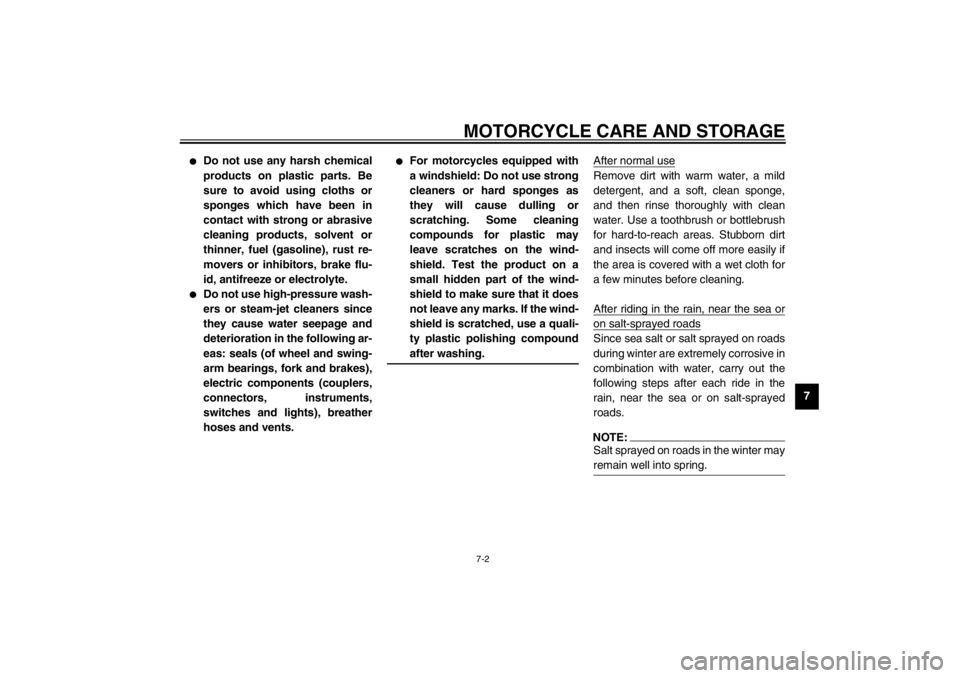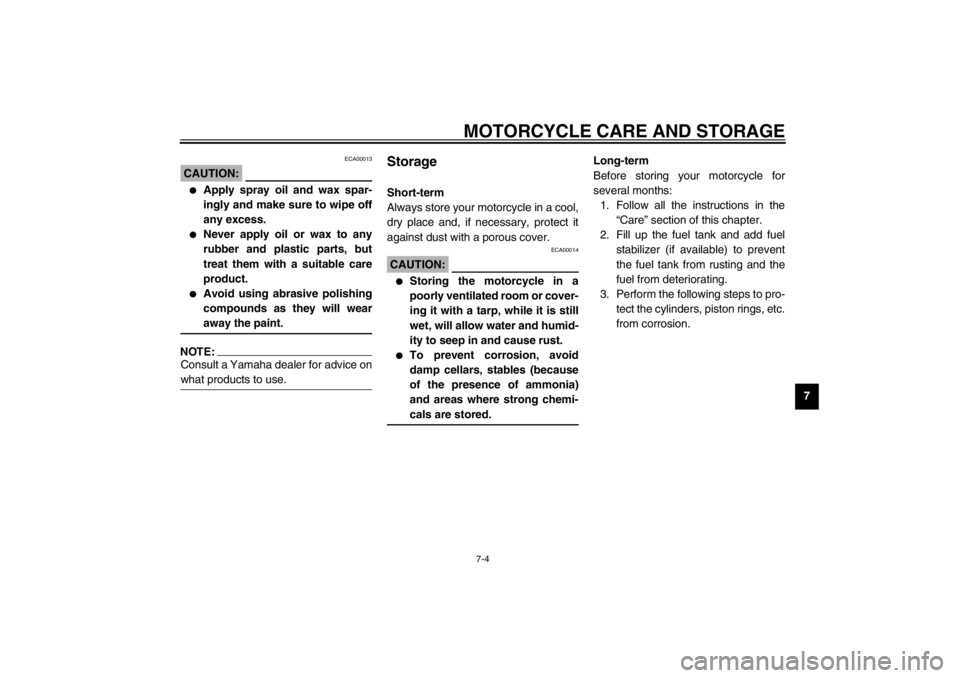Page 79 of 110

PERIODIC MAINTENANCE AND MINOR REPAIR
6-34
6
EC000102
CAUTION:@ �
Always keep the battery
charged. Storing a discharged
battery can cause permanent
battery damage.
�
To charge a sealed-type (MF)
battery, a special (constant-
voltage) battery charger is re-
quired. Using a conventional
battery charger will damage the
battery. If you do not have ac-
cess to a sealed-type (MF) bat-
tery charger, have a Yamaha
dealer charge your battery.
@
EAU04482*
Replacing the fuses The main fuse and the fuse box, which
contains the fuses for the individual cir-
cuits, are located under the seat. (See
page 3-11 for seat removal and instal-
lation procedures.)
If a fuse is blown, replace it as follows.
1. Turn the key to “OFF” and turn off
the electrical circuit in question.2. Remove the blown fuse, and then
install a new fuse of the specified
amperage.
EC000103
CAUTION:_ Do not use a fuse of a higher amper-
age rating than recommended to
avoid causing extensive damage to
the electrical system and possibly a
fire. _
1. Backup fuse (odometer and clock)
2. Radiator fan fuse
3. Turn signal and hazard light fuse
4. Ignition fuse
5. Signaling system fuse
6. Headlight fuse
7. Spare fuse (× 4)
8. Parking lighting fuse
9. Electronic Fuel Injection System fuse
10. Main fuse
Specified fuses:
Main fuse: 40 A
Headlight fuse: 15 A
Signaling system fuse: 7.5 A
Radiator fan fuse: 20 A
Ignition fuse: 10 A
Backup fuse (odometer
and clock): 5 A
Turn signal and hazard
light fuse: 10 A
Parking lighting fuse: 5 A
Electronic Fuel Injection
System fuse: 10 A
U5PSE0.book Page 34 Thursday, December 13, 2001 4:29 PM
Page 87 of 110
PERIODIC MAINTENANCE AND MINOR REPAIR
6-42
6
EAU03087
Troubleshooting Although Yamaha motorcycles receive
a thorough inspection before shipment
from the factory, trouble may occur dur-
ing operation. Any problem in the fuel,
compression, or ignition systems, for
example, can cause poor starting and
loss of power.
The following troubleshooting charts
represent quick and easy procedures
for checking these vital systems your-
self. However, should your motorcycle
require any repair, take it to a Yamaha
dealer, whose skilled technicians have
the necessary tools, experience, and
know-how to service the motorcycle
properly.
Use only genuine Yamaha replace-
ment parts. Imitation parts may look
like Yamaha parts, but they are often
inferior, have a shorter service life and
can lead to expensive repair bills.
U5PSE0.book Page 42 Thursday, December 13, 2001 4:29 PM
Page 88 of 110

PERIODIC MAINTENANCE AND MINOR REPAIR
6-43
6
EAU02990
Troubleshooting charts Starting problems or poor engine performance
EW000125
WARNING
@ Keep away open flames and do not smoke while checking or working on the fuel system. @
CT-1AE
Check the fuel level in
the fuel tank.1. Fuel
There is enough fuel.
There is no fuel.
Check the compression.
Supply fuel.
The engine does not start.
Check the compression.
Operate the electric starter.2. Compression
There is compression.
There is no compression.
Check the ignition.
Have a Yamaha dealer
check the vehicle.
Remove the spark plugs
and check the electrodes.3. Ignition
Wipe off with a dry cloth and correct the
spark plug gaps, or replace the spark plugs.
Have a Yamaha dealer check the vehicle.
The engine does not start.
Have a Yamaha dealer
check the vehicle.
The engine does not start.
Check the battery.
Operate the electric starter.4. Battery
The engine turns over
quickly.
The engine turns over
slowly.
The battery is good.Check the battery lead connections,
and charge the battery if necessary.
DryWet
Open the throttle halfway and operate
the electric starter.
U5PSE0.book Page 43 Thursday, December 13, 2001 4:29 PM
Page 93 of 110

MOTORCYCLE CARE AND STORAGE
7-2
7
�
Do not use any harsh chemical
products on plastic parts. Be
sure to avoid using cloths or
sponges which have been in
contact with strong or abrasive
cleaning products, solvent or
thinner, fuel (gasoline), rust re-
movers or inhibitors, brake flu-
id, antifreeze or electrolyte.
�
Do not use high-pressure wash-
ers or steam-jet cleaners since
they cause water seepage and
deterioration in the following ar-
eas: seals (of wheel and swing-
arm bearings, fork and brakes),
electric components (couplers,
connectors, instruments,
switches and lights), breather
hoses and vents.
�
For motorcycles equipped with
a windshield: Do not use strong
cleaners or hard sponges as
they will cause dulling or
scratching. Some cleaning
compounds for plastic may
leave scratches on the wind-
shield. Test the product on a
small hidden part of the wind-
shield to make sure that it does
not leave any marks. If the wind-
shield is scratched, use a quali-
ty plastic polishing compound
after washing.
_
After normal useRemove dirt with warm water, a mild
detergent, and a soft, clean sponge,
and then rinse thoroughly with clean
water. Use a toothbrush or bottlebrush
for hard-to-reach areas. Stubborn dirt
and insects will come off more easily if
the area is covered with a wet cloth for
a few minutes before cleaning.
After riding in the rain, near the sea oron salt-sprayed roadsSince sea salt or salt sprayed on roads
during winter are extremely corrosive in
combination with water, carry out the
following steps after each ride in the
rain, near the sea or on salt-sprayed
roads.NOTE:_ Salt sprayed on roads in the winter may
remain well into spring. _
U5PSE0.book Page 2 Thursday, December 13, 2001 4:29 PM
Page 95 of 110

MOTORCYCLE CARE AND STORAGE
7-4
7
ECA00013
CAUTION:_ �
Apply spray oil and wax spar-
ingly and make sure to wipe off
any excess.
�
Never apply oil or wax to any
rubber and plastic parts, but
treat them with a suitable care
product.
�
Avoid using abrasive polishing
compounds as they will wear
away the paint.
_NOTE:_ Consult a Yamaha dealer for advice on
what products to use. _
Storage Short-term
Always store your motorcycle in a cool,
dry place and, if necessary, protect it
against dust with a porous cover.
ECA00014
CAUTION:_ �
Storing the motorcycle in a
poorly ventilated room or cover-
ing it with a tarp, while it is still
wet, will allow water and humid-
ity to seep in and cause rust.
�
To prevent corrosion, avoid
damp cellars, stables (because
of the presence of ammonia)
and areas where strong chemi-
cals are stored.
_
Long-term
Before storing your motorcycle for
several months:
1. Follow all the instructions in the
“Care” section of this chapter.
2. Fill up the fuel tank and add fuel
stabilizer (if available) to prevent
the fuel tank from rusting and the
fuel from deteriorating.
3. Perform the following steps to pro-
tect the cylinders, piston rings, etc.
from corrosion.
U5PSE0.book Page 4 Thursday, December 13, 2001 4:29 PM
Page 98 of 110

8-1
8
EAU01038
8-SPECIFICATIONSSpecifications CS-01E
CS-01EModel TDM900
Dimensions
Overall length 2,180 mm
Overall width 800 mm
Overall height 1,290 mm
Seat height 825 mm
Wheelbase 1,485 mm
Ground clearance 160 mm
Minimum turning radius 2,900 mm
Basic weight (with oil and full
fuel tank)
221 kg
Engine
Engine type Liquid-cooled 4-stroke, DOHC
Cylinder arrangement Forward-inclined parallel
2-cylinder
Displacement 897 cm
3
Bore × stroke 92.0 × 67.5 mm
Compression ratio 10.4:1
Starting system Electric starter
Lubrication system Dry sumpEngine oil
Ty p e
Recommended engine oil
classification API Service SE, SF, SG or
higher
Quantity
Without oil filter element
replacement 3.8 L
With oil filter element
replacement 3.9 L
Total amount (dry engine) 4.7 L
-20 -10 0
10 20 30
40
50 ˚C
SAE 10W-30
SAE 15W-40SAE 20W-40SAE 20W-50
SAE 10W-40
CAUTION:Be sure to use motor oils that do not contain anti-friction
modifiers. Passenger car motor oils (often labeled
“ENERGY CONSERVING II”) contain anti-friction additives
which will cause clutch and/or starter clutch slippage, result-
ing in reduced component life and poor engine performance.
U5PSE0.book Page 1 Thursday, December 13, 2001 4:29 PM
Page 99 of 110

SPECIFICATIONS
8-2
8
Cooling system capacity
(total amount)
1.7 L
Air filterWet type element
Fuel
Type REGULAR UNLEADED
GASOLINE ONLY
Fuel tank capacity 20 L
Fuel reserve amount 3.5 L
Spark plug
Manufacturer/model NGK / DPR8EA-9 or
DENSO / X24EPR-U9
Gap 0.8–0.9 mm
Clutch typeWet, multiple-disc
Transmission
Primary reduction system Spur gear
Primary reduction ratio 1.718
Secondary reduction system Chain drive
Secondary reduction ratio 2.625
Number of drive chain
sprocket teeth (front/rear) 16/42
Transmission type Constant-mesh 6-speedOperation Left foot
Gear ratio
1st 2.750
2nd 1.947
3rd 1.545
4th 1.240
5th 1.040
6th 0.923
Chassis
Frame type Diamond
Caster angle 25.5°
Trail 114 mm
Tires
Front
Type Tubeless tire
Size 120/70 ZR18 (59W)
120/70 ZR18 M/C (59W)
Manufacturer/model Dunlop / D220FSTJ
Metzeler / MEZ4J
Rear
Type Tubeless tire
Size 160/60 ZR17 (69W)
160/60 ZR17 M/C (69W)
Manufacturer/model Dunlop / D220STJ
Metzeler / MEZ4J
U5PSE0.book Page 2 Thursday, December 13, 2001 4:29 PM
Page 101 of 110
SPECIFICATIONS
8-4
8
Electrical system
Ignition system T.C.I. (digital)
Charging system
Type A.C. magneto
Standard output 14 V, 31.5 A @ 5,000 r/min
Battery
Model GT12B-4
Voltage, capacity 12 V, 10 Ah
Headlight typeQuar tz bulb (halogen)
Bulb voltage, wattage × quantity
Headlight 12 V, 55 W × 2
Auxiliary light 12 V, 5 W × 1
Tail/brake light 12 V, 5/21 W × 2
Turn signal light 12 V, 10 W × 4
Meter lighting 12 V, 2 W × 2
Neutral indicator light 14 V, 1.2 W × 1
High beam indicator light 14 V, 1.4 W × 1
Turn signal indicator light 14 V, 1.2 W × 2
Oil level warning light L.E.D.
Engine trouble warning light 14 V, 1.4 W × 1Fuses
Main fuse 40 A
Headlight fuse 15 A
Signaling system fuse 7.5 A
Ignition fuse 10 A
Parking lighting fuse 5 A
Turn signal and hazard light
fuse 10 A
Backup fuse (odometer and
clock) 5 A
Radiator fan fuse 20 A
Electronic Fuel Injection
System fuse 10 A
U5PSE0.book Page 4 Thursday, December 13, 2001 4:29 PM